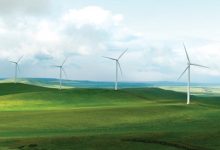For the better part of the past decade, the federal Coalition’s key weapon in its inexplicable ideological war against renewable energy (and climate action) has been the threat of runaway electricity prices.
Barely a month into his role as federal minister for energy and “getting prices down,” Angus Taylor told Sky News that edging out Australia’s coal plants too quickly, with “too much” cheap wind and solar, would “drive up the price of electricity” and “make the whole system… far less affordable.”
One election victory and just over 19 months later, a new report from energy market analysts Reputex, has made the case that the exact opposite would be true.
The report, published on Wednesday, finds that the faster the shift to a power market dominated by renewable energy – and the more aggressive the action on climate change – the greater the downward pressure on future wholesale electricity prices.
A slower transition, on the other hand, guided only by “current policy” – or lack thereof, at the federal level – would have the inverse effect.
That is, a failure to properly incentivise investment in new clean energy generation ahead of the inevitable retirement of Australia’s ageing coal-fired fleet would to lead to higher wholesale electricity prices. And that’s where we’re headed under the Morrison government’s current settings.
Under a business-as-usual scenario, Reputex says, short-term commissioning of renewable projects, alongside investment driven by state schemes and rooftop solar uptake, would still manage to get Australia to around 75 per cent renewables by 2040.
And while an electricity market transition on this ort of trajectory would keep wholesale power prices down around $50-$70/MWh for most of the 2020s, the wholesale market would take a sharp turn for the worse from there.
“With no effective NEM-wide framework to guide new investment prior to coal-fired retirements, a return to elevated wholesale prices will be required to incentivise new capacity additions beyond 2030”, said Reputex head of research Bret Harper.
“This reflects current policy uncertainty, with renewables investment likely to become reactive to coal-fired closures, and higher prices, rather than being proactively incentivised by policy ahead of expected retirements.”
Happily, there is an alternative – and even more happily, it has already been mapped out. Reputex models its “orderly transition” case on the Step Change scenario outlined in the Australian Energy Market Operator’s draft Integrated System Plan of 2019-2020.
According to RepuTex, under AEMO’s more ambitious scenario, the addition of larger volumes of renewables and advances in energy storage technology would prove a “fatal combination” for coal, with two-thirds (63%) of Australia’s thermal capacity forecast to exit the market by 2040.
“This will see Australia reach 70 per cent renewable energy generation by 2030, growing to 90 per cent in 2040, behind almost 77GW of new clean energy capacity,” the report says.
“With the faster take-up of renewable energy and distributed technologies such as Virtual Power Plant (VPP) batteries, traditional ‘baseload’ demand profiles are forecast to be eroded much faster under a step change scenario”, adds Harper.
“With a ‘peakier’ demand profile and more variable renewable energy capacity, the market is likely to place greater value on flexible capacity to balance the system. Closure of the least-value generation facilities is therefore the modelled outcome.”
According to this scenario, RepuTex forecasts that annual average prices would remain below $80/MWh in the 2030s, due to falling energy storage costs, and the market-calming effect of policy incentivising investment in new capacity ahead of expected coal facility retirements.
“Modelling indicates it is possible to de-carbonise the NEM, maintain reliability, and keep average wholesale electricity prices below $80/MW,” said Harper.
“While coal-fired retirements, along with increasing consumption and more variable generation, is forecast to lead to more volatile prices in the 2030s, the shift to a power market dominated by renewable is not forecast to trigger large increases in wholesale prices,” he said.
“In particular, firmed solar and wind are forecast to have lower costs than fossil fuel facilities by the 2030s. Replacing Australia’s ageing thermal fleet with new flexible capacity is therefore likely to maintain lower wholesale prices.”
And one more time for the people up the back:
“Given the National Electricity Market’s ageing thermal generation fleet and Australia’s commitment to the Paris Agreement, there is greater risk in moving too slowly than moving too fast,” Harper said.
“The more orderly the transition, the better for avoiding a return to a high price environment.”
RenewEconomy and its sister sites One Step Off The Grid and The Driven will continue to publish throughout the Covid-19 crisis, posting good news about technology and project development, and holding government, regulators and business to account. But as the conference market evaporates, and some advertisers pull in their budgets, readers can help by making a voluntary donation here to help ensure we can continue to offer the service free of charge and to as wide an audience as possible. Thankyou for your support.










